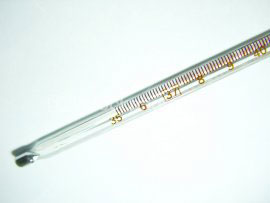Thermometers
There are many types of thermometers available. The most common type are the digital thermometers. These can be used at any age from birth. They are easy to use and accurate, and are usually the cheapest. The electronic ear thermometer is expensive, and it is not suitable for use in small babies.
How to use a digital thermometer
Digital thermometers can be used for all ages. They give a digital read out. There are a number of brands. They are usually the cheapest option. You need to read and follow the instructions that come with your one.
If your child is under 5 years, you can use the digital thermometer under the arm. If you measure the temperature under the arm, it records about half to 1 (0.5 - 1.0) degree Celsius lower than the core temperature.
To use a digital thermometer under the arm (the axillary temperature):
 1.turn it on (these thermometers usually have a button you press to turn on)
1.turn it on (these thermometers usually have a button you press to turn on)- 2.place the end in the armpit against the skin, and bring your child's arm down over the top of it. It often helps to hug your child to keep the arm down and the thermometer in place
most thermometers beep when they have finished meansuring your child's temperature
some thermometers also beep while measuring and the beep changes when the thermometer has finished measuring your child's temperature. To avoid confusion, it is worth keeping the thermometer in place for 2 minutes
remove the thermometer and read the number on the side. The temperature you read is about half to 1 degree Celsius lower than your child's actual body or core temperature
If your child is 5 years of age or older you can try to measure the temperature in the mouth (the oral temperature). Make sure you only use a digital thermometer in your child's mouth.
To use it in the mouth in older children:
- 1.your child has to be able to cooperate, which usually means they are of school age
- 2.turn it on
- 3.place the end in the mouth under the side of the tongue. Try to get your child to keep it there
some thermometers make beeping noises when they have finished, but it is worth keeping it in place for at least 2 minutes
- 4.remove the thermometer and read the number on the side. The temperature you read in in degrees Celsius is close to your child's actual body or core temperature
How to use an ear thermometer

The electronic or infrared ear thermometer is fast and accurate if it is used correctly. It can be used in older children but is not recommended for use in young babies.
There are a number of brands. They are more expensive than digital thermometers.
Read the instructions for your thermometer to find out how to turn it on and take the reading. When placing the measuring end in the ear, be gentle. You do not have to push it far into the ear canal, just at the entrance.
How to use an infrared forehead thermometer
Infrared forehead thermometers are quick and easy to use, as you simply point them at your child's forehead. But, they are expensive and it is not clear how accurate they are. They measure the forehead skin temperature which changes a lot with blood flow and room temperature.
Plastic strip thermometer
These are plastic strips that you place on your child's forehead. They are not accurate, and we don't recommend them.
Mercury-in-glass thermometer
These old style thermometers are no longer available but some households still have them. Mercury vapour can be toxic if the thermometer breaks, so we recommend you don't use these thermometers and consider getting a digital thermometer instead.
:max_bytes(150000):strip_icc():format(webp)/Isotope-58dd6b415f9b5846830254ae.jpg)


 1.turn it on (these thermometers usually have a button you press to turn on)
1.turn it on (these thermometers usually have a button you press to turn on)
 The electronic or infrared ear thermometer is fast and accurate if it is used correctly. It can be used in older children but is not recommended for use in young babies.
The electronic or infrared ear thermometer is fast and accurate if it is used correctly. It can be used in older children but is not recommended for use in young babies.

